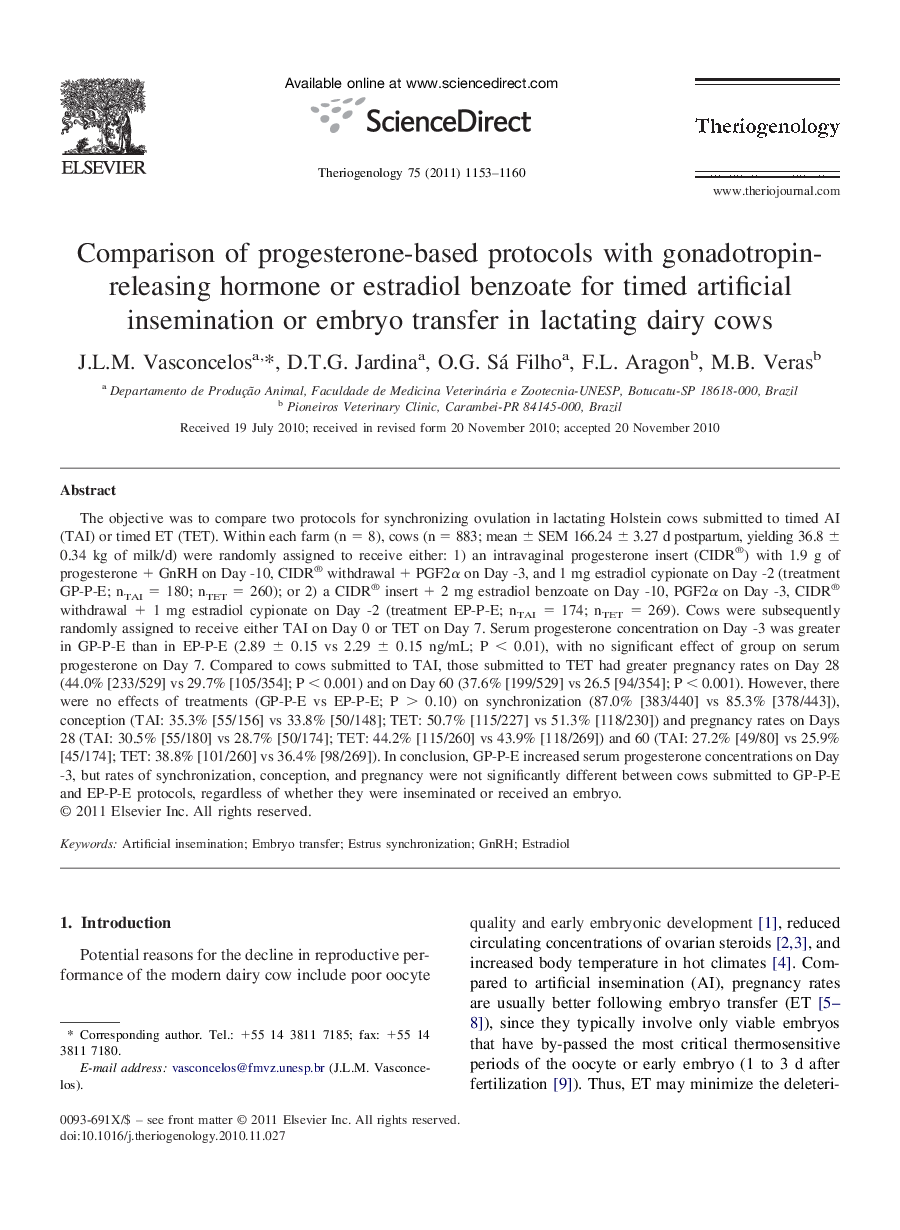| کد مقاله | کد نشریه | سال انتشار | مقاله انگلیسی | نسخه تمام متن |
|---|---|---|---|---|
| 10893131 | 1082147 | 2011 | 8 صفحه PDF | دانلود رایگان |
عنوان انگلیسی مقاله ISI
Comparison of progesterone-based protocols with gonadotropin-releasing hormone or estradiol benzoate for timed artificial insemination or embryo transfer in lactating dairy cows
دانلود مقاله + سفارش ترجمه
دانلود مقاله ISI انگلیسی
رایگان برای ایرانیان
کلمات کلیدی
موضوعات مرتبط
علوم زیستی و بیوفناوری
علوم کشاورزی و بیولوژیک
علوم دامی و جانورشناسی
پیش نمایش صفحه اول مقاله

چکیده انگلیسی
The objective was to compare two protocols for synchronizing ovulation in lactating Holstein cows submitted to timed AI (TAI) or timed ET (TET). Within each farm (n = 8), cows (n = 883; mean ± SEM 166.24 ± 3.27 d postpartum, yielding 36.8 ± 0.34 kg of milk/d) were randomly assigned to receive either: 1) an intravaginal progesterone insert (CIDR®) with 1.9 g of progesterone + GnRH on Day -10, CIDR® withdrawal + PGF2α on Day -3, and 1 mg estradiol cypionate on Day -2 (treatment GP-P-E; nTAI = 180; nTET = 260); or 2) a CIDR® insert + 2 mg estradiol benzoate on Day -10, PGF2α on Day -3, CIDR® withdrawal + 1 mg estradiol cypionate on Day -2 (treatment EP-P-E; nTAI = 174; nTET = 269). Cows were subsequently randomly assigned to receive either TAI on Day 0 or TET on Day 7. Serum progesterone concentration on Day -3 was greater in GP-P-E than in EP-P-E (2.89 ± 0.15 vs 2.29 ± 0.15 ng/mL; P < 0.01), with no significant effect of group on serum progesterone on Day 7. Compared to cows submitted to TAI, those submitted to TET had greater pregnancy rates on Day 28 (44.0% [233/529] vs 29.7% [105/354]; P < 0.001) and on Day 60 (37.6% [199/529] vs 26.5 [94/354]; P < 0.001). However, there were no effects of treatments (GP-P-E vs EP-P-E; P > 0.10) on synchronization (87.0% [383/440] vs 85.3% [378/443]), conception (TAI: 35.3% [55/156] vs 33.8% [50/148]; TET: 50.7% [115/227] vs 51.3% [118/230]) and pregnancy rates on Days 28 (TAI: 30.5% [55/180] vs 28.7% [50/174]; TET: 44.2% [115/260] vs 43.9% [118/269]) and 60 (TAI: 27.2% [49/80] vs 25.9% [45/174]; TET: 38.8% [101/260] vs 36.4% [98/269]). In conclusion, GP-P-E increased serum progesterone concentrations on Day -3, but rates of synchronization, conception, and pregnancy were not significantly different between cows submitted to GP-P-E and EP-P-E protocols, regardless of whether they were inseminated or received an embryo.
ناشر
Database: Elsevier - ScienceDirect (ساینس دایرکت)
Journal: Theriogenology - Volume 75, Issue 6, 1 April 2011, Pages 1153-1160
Journal: Theriogenology - Volume 75, Issue 6, 1 April 2011, Pages 1153-1160
نویسندگان
J.L.M. Vasconcelos, D.T.G. Jardina, O.G. Sá Filho, F.L. Aragon, M.B. Veras,